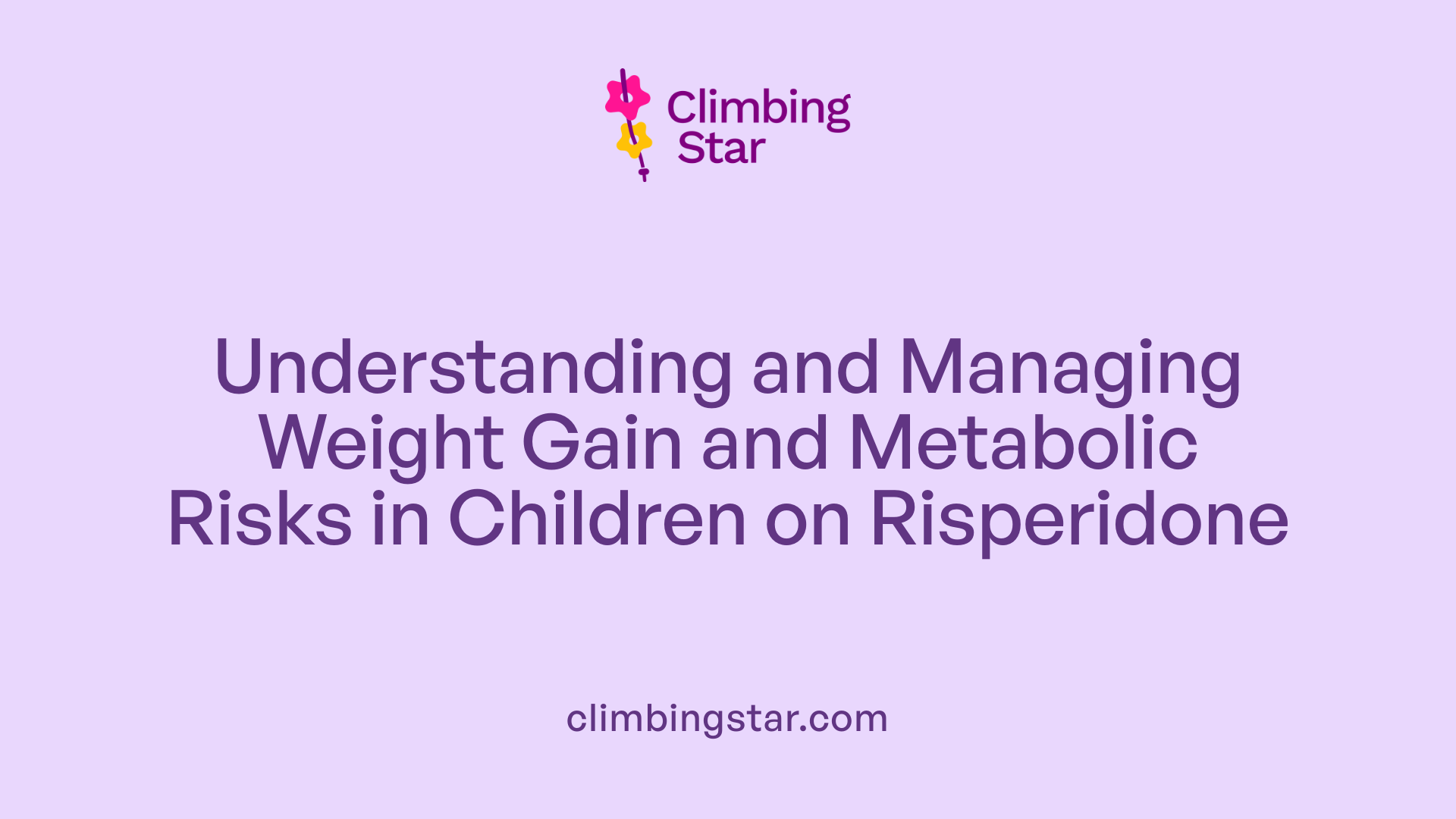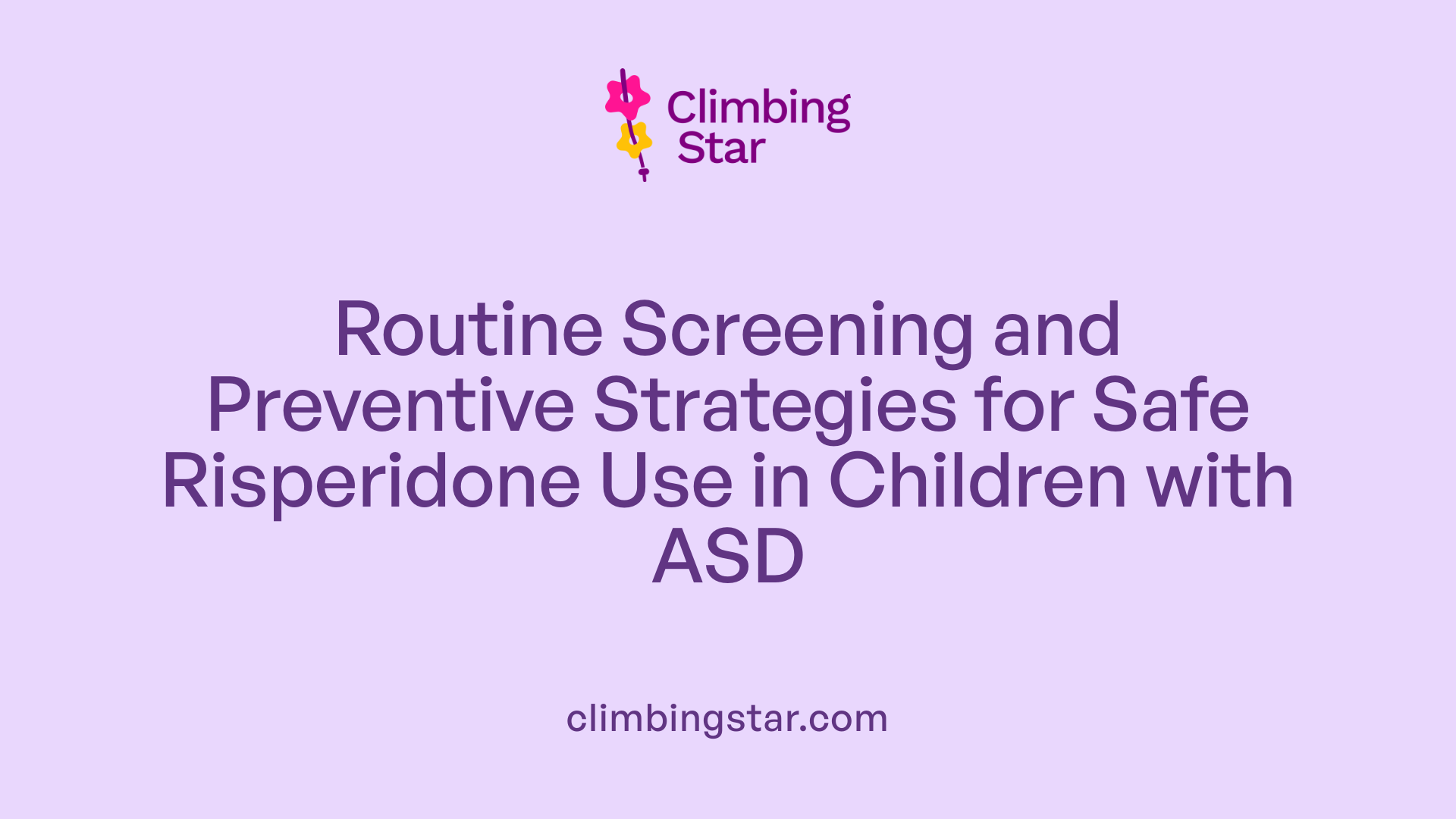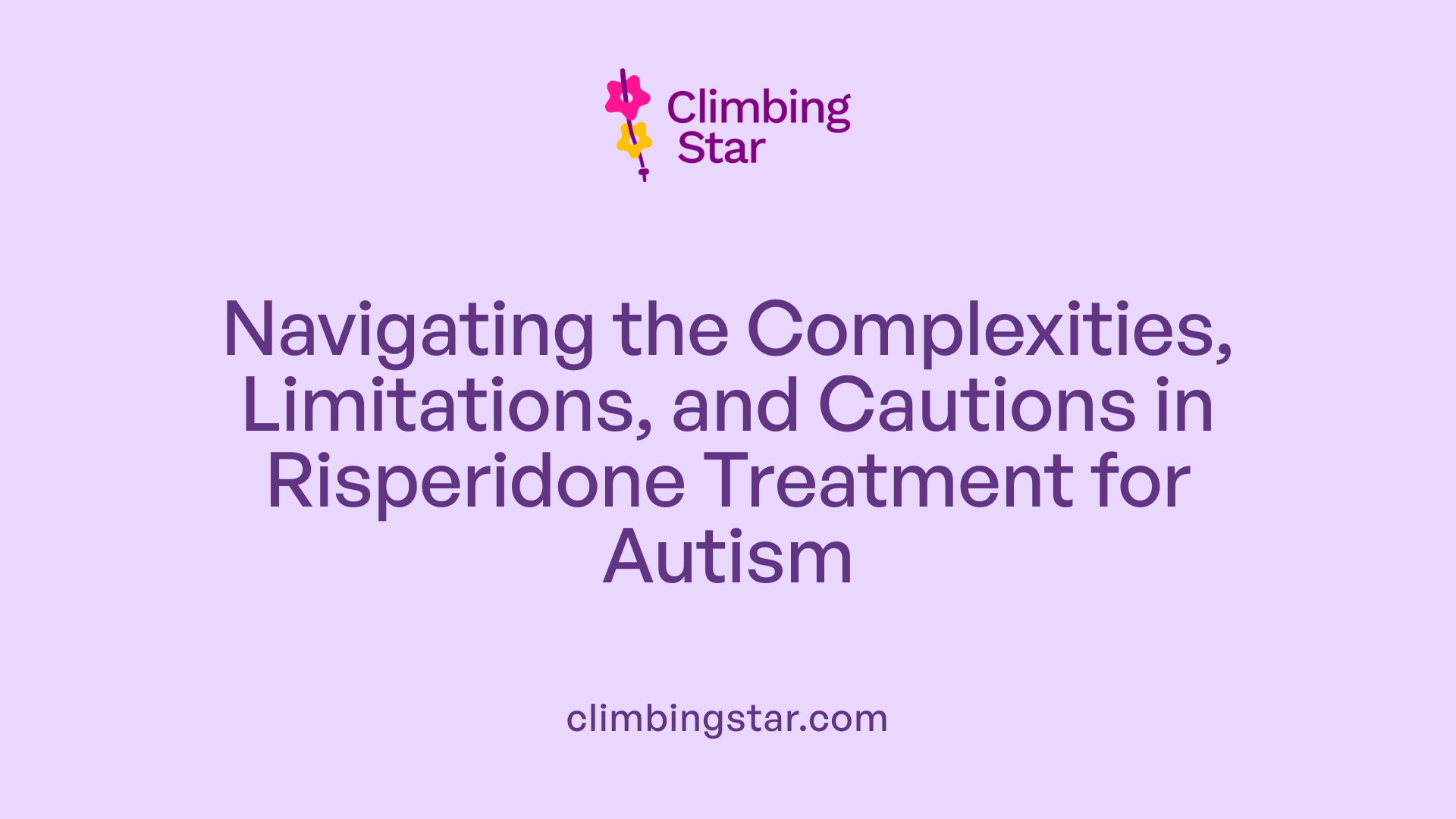Introduction to Risperidone Use in Autism Spectrum Disorder (ASD)
Risperidone, an atypical antipsychotic medication, has emerged as a key pharmacological option for managing behavioral challenges in children with Autism Spectrum Disorder (ASD). Approved by the U.S. Food and Drug Administration (FDA) specifically to treat irritability and aggression in ASD, risperidone offers significant benefits in reducing problematic behaviors, thereby helping many children function better both at home and in school settings. Despite its efficacy, risperidone's use requires careful consideration due to its side effect profile, particularly rapid weight gain and metabolic risks, which necessitate diligent monitoring. This article explores risperidone's therapeutic role, its side effects, and complementary behavioral interventions to provide a comprehensive understanding of its place in autism treatment.
Efficacy of Risperidone in Managing Behavioral Symptoms of ASD
What is risperidone’s role in treating behavioral problems in children with autism?
Risperidone is an atypical antipsychotic that is FDA-approved for managing irritability and aggression in children with Autism Spectrum Disorder (ASD). It works by blocking dopamine and serotonin receptors, which helps reduce behavioral disturbances such as tantrums, aggression, and self-injury.
How effective is risperidone in reducing behavioral symptoms in ASD?
Clinical studies show that risperidone significantly decreases problematic behaviors. In a multisite, randomized trial involving 101 children aged 5 to 17, treatment with risperidone led to a 56.9% reduction in irritability scores on the Aberrant Behavior Checklist compared to a 14.1% decrease in those receiving placebo. Around 69% of children on risperidone demonstrated marked improvement, defined by at least a 25% decrease in irritability and notable clinical improvement.
What behavioral symptoms are targeted by risperidone?
Risperidone effectively reduces irritability, aggression, tantrums, stereotypies, social withdrawal, hyperactivity, and inappropriate speech. It is primarily used to manage severe behaviors that interfere with daily functioning at home and school.
What are the clinical trial outcomes supporting risperidone’s use?
In addition to the significant decrease in irritability, risperidone's positive effects were maintained for six months in about two-thirds of responders. Overall, it demonstrated a large effect size (1.05 to 1.11) in meta-analyses, indicating strong improvements in behavioral symptoms. Most adverse effects were mild and tolerable, with no serious events during short-term treatment.
How does FDA approval reflect risperidone's impact?
The FDA approves risperidone specifically for treating irritability associated with ASD, highlighting its recognized role in controlling symptoms such as aggression and tantrums where behavioral interventions alone may be insufficient. Its use is often recommended during crises, with the goal of eventually transitioning to behavioral therapies.
Understanding the Pharmacological Mechanism of Risperidone
What is risperidone's drug class?
Risperidone belongs to the class of atypical antipsychotics. This classification distinguishes it from older, typical antipsychotics by its broader receptor profile and generally more favorable side effect profile. Atypical antipsychotics tend to cause fewer movement-related side effects and are used for various psychiatric conditions.
How does risperidone work in managing behaviors associated with autism?
Risperidone works primarily by blocking postsynaptic dopamine and serotonin receptors in the brain. This dual receptor blockade helps regulate neural pathways linked to mood, aggression, and impulsivity. By modulating these neurotransmitter systems, risperidone reduces behavioral disturbances common in children with autism spectrum disorder (ASD), such as irritability, tantrums, aggression, and self-injury.
What are the advantages of this mechanism for behavioral symptoms in autism?
Risperidone’s action on both dopamine and serotonin receptors gives it a broad spectrum of efficacy in managing challenging behaviors. Unlike medications targeting only one neurotransmitter, its combined antagonism allows for more comprehensive symptom control. This mechanism helps decrease irritability and aggression, improves social engagement to some extent, and reduces repetitive behaviors without excessive sedation.
In clinical settings, this translates to improved functioning at home and school for many children with ASD. The relatively low doses of risperidone needed to achieve behavioral benefits also minimize risks, although side effects like weight gain remain a concern requiring monitoring.
Overall, risperidone’s pharmacological profile makes it a valuable option in the therapeutic arsenal against behavioral problems in autism, complementing behavioral therapies with effective symptom relief.
Common and Manageable Side Effects of Risperidone Treatment

What are the common side effects of risperidone in children with ASD?
Risperidone, widely prescribed for managing behavioral symptoms in children with autism spectrum disorder (ASD), is associated with several common side effects. Increased appetite is one of the most frequently reported adverse effects, often emerging early during treatment and contributing to subsequent weight gain.
Somnolence, fatigue, and drowsiness are also commonly observed, reflecting the sedative properties of risperidone. These symptoms tend to be mild and improve over time with ongoing monitoring.
Other mild side effects include rhinorrhea (nasal discharge) and drooling. Though less disruptive, these symptoms are common enough to warrant attention during clinical evaluations.
Neurological effects such as tremor can occasionally occur but are generally mild and not consistently observed during weekly clinical assessments.
Overall, about 87% of children in a cross-sectional study reported some type of adverse effect, yet most were tolerable and manageable without serious complications. The frequency and mild nature of these side effects emphasize the importance of regular monitoring but also support the relative safety of risperidone under careful use.
Tables summarizing common side effects and their clinical implications can aid healthcare providers in anticipating and managing these events effectively.
Weight Gain and Metabolic Risks with Risperidone

Why is weight gain a concerning adverse effect of risperidone?
Risperidone treatment in children with autism spectrum disorder (ASD) often leads to significant weight gain. Studies, including one conducted at Siriraj Hospital in Thailand, found an average weight gain of 4.18 kg per year, which exceeds expected developmental growth. This rapid increase is primarily driven by an early rise in appetite observed soon after starting therapy.
Early increased appetite and its implications
Increased appetite is one of the earliest adverse effects noted with risperidone use. It typically precedes the weight gain, suggesting that appetite stimulation is a central mechanism behind the observed weight changes. This early effect necessitates timely dietary guidance and weight monitoring to minimize excessive calorie intake.
Metabolic syndrome and long-term health concerns
Significant weight gain associated with risperidone places affected children at higher risk for developing metabolic syndrome, a cluster of conditions that include insulin resistance, elevated blood pressure, and abnormal cholesterol levels. These factors increase the likelihood of serious chronic diseases such as type 2 diabetes, cardiovascular disease, and liver disease. Continuous monitoring of metabolic parameters during treatment is therefore critical.
The need for diet and weight management
Given these risks, initiating diet and weight management strategies from the outset of risperidone treatment is vital. Recommendations include restricting high-calorie foods and sugary beverages to prevent unhealthy weight gain. Regular follow-up assessments of weight, appetite, and metabolic health markers help manage side effects effectively.
These precautions are essential to ensure risperidone’s benefits in managing ASD-related behavioral issues are not overshadowed by preventable metabolic complications.
Long-Term Safety: Absence of Serious Neurological Side Effects
Are serious neurological side effects like tardive dyskinesia seen with risperidone in children with autism?
Longitudinal research, including a notable cross-sectional study of children aged 2–15 years treated with risperidone for an average of approximately three years, reveals no occurrences of tardive dyskinesia, a serious and often irreversible neurological side effect. This suggests that extended risperidone use in pediatric autism spectrum disorder (ASD) populations does not commonly precipitate this movement disorder.
Neurological assessments during trials
Throughout various clinical trials, neurological evaluations were regularly conducted. Weekly assessments specifically screened for extrapyramidal symptoms, including tremors and other movement abnormalities. While some children experienced mild neurological effects such as tremors, these were uncommon and not consistently observed during scheduled clinical evaluations. No serious or persistent neurological adverse events were reported, and the observed mild effects tended to be transient and self-limited.
Safety profile over multiple years
The cumulative evidence underscores risperidone’s relatively safe neurological profile when used under careful monitoring in children with ASD. Despite concerns typically associated with antipsychotics, longitudinal data show no development of tardive dyskinesia or similarly severe neurological complications during treatment periods extending to several years. This favorable safety profile, combined with efficacy in managing ASD-related behavioral symptoms, supports its continued cautious use, provided that neurological function is routinely assessed.
Role of Behavioral Interventions Alongside Risperidone
What is Applied Behavior Analysis (ABA) therapy?
Applied Behavior Analysis (ABA) therapy is a scientifically-based approach aimed at improving a wide array of skills and reducing problematic behaviors in individuals with autism. It utilizes learning principles such as positive reinforcement and continuous data collection to tailor interventions to each individual's needs. ABA programs focus on boosting communication, social interaction, self-care, and academic abilities.
Who provides ABA therapy and what qualifications do they typically have?
ABA therapy is usually delivered by specialists known as Board Certified Behavior Analysts (BCBAs) who possess advanced training and certification in behavioral principles and intervention strategies. They work alongside behavior technicians who help implement and oversee therapy sessions under their supervision. This expert team develops, monitors, and updates personalized treatment plans to ensure therapeutic goals are met effectively.
How does ABA therapy help individuals with autism?
ABA therapy supports individuals with autism by systematically teaching functional skills and encouraging positive behavior while reducing challenging behaviors. Structured programs foster developmental gains, increasing independence and improving quality of life. The approach is highly individualized, adjusting techniques based on ongoing assessments.
How do behavioral interventions complement risperidone treatment?
When combined with risperidone, behavioral interventions such as ABA provide a comprehensive approach to managing challenging behaviors in children with autism. For example, in the Thai study at Siriraj Hospital, a parent training program grounded in ABA principles was implemented alongside risperidone therapy. This parent training slightly reduced the necessary medication dosage, suggesting behavioral interventions can enhance or potentially minimize reliance on pharmacologic treatments. However, the training did not significantly affect adverse outcomes like weight gain.
Impact of parent training programs on medication dosage and outcomes
Parent training programs teach caregivers effective techniques to manage behavioral problems, which can reinforce gains made during pharmacological treatment. While such programs can lower medication dosages slightly, studies indicate that the side effects of risperidone (notably weight gain and increased appetite) still persist and require active monitoring.
Together, risperidone and ABA therapy offer complementary benefits: the medication can rapidly reduce severe behavioral symptoms, while ABA promotes sustainable skill development and behavior management. This integrative approach underscores the importance of combining medication with high-quality behavioral interventions to optimize outcomes for children with autism spectrum disorder.
Common ABA Techniques Relevant to ASD Behavioral Management
What are common techniques used in ABA therapy?
Applied Behavior Analysis (ABA) therapy implements several effective techniques tailored for managing behavioral challenges in children with Autism Spectrum Disorder (ASD).
Positive reinforcement is foundational in ABA; it involves rewarding desired behaviors promptly to increase their occurrence. For example, giving praise or a small reward when a child follows a direction.
Discrete Trial Training (DTT) breaks complex skills into smaller, manageable steps, teaching each step through clear instructions and repeated practice. This approach facilitates learning of specific behaviors or skills efficiently.
Prompting and fading techniques support the child initially by giving cues or assistance to perform a behavior. Gradually, the prompts are reduced (faded) to promote independent behavior.
Behavior chaining and modeling include teaching a sequence of linked behaviors (chaining) and demonstrating the desired behavior for imitation (modeling). These are useful for tasks requiring multiple steps, such as washing hands or getting dressed.
Functional Communication Training (FCT) focuses on teaching alternative communication methods to replace challenging behaviors that serve the same communicative function, like teaching a child to request help instead of acting out.
Additionally, ABA incorporates strategies like extinction (reducing behaviors by withholding reinforcement), social skills training, and the use of visual supports to enhance understanding and generalization of skills.
These ABA methods work synergistically to modify behaviors, build new skills, and encourage independence in children with ASD, making them a cornerstone of behavioral management in this population.
Integrating Risperidone with Behavioral Therapy: Considerations and Outcomes
Combined Treatment Impact
Risperidone, an effective medication for managing irritability and aggression in children with autism spectrum disorder (ASD), is often used alongside behavioral therapies. Studies have shown that while risperidone reduces severe behavioral problems, the addition of behavioral interventions, such as parent training programs based on applied behavior analysis (ABA), can enhance treatment outcomes. ABA-based parent programs focus on modifying behaviors through structured training, complementing pharmacological effects.
Parent Training Effects on Medication Dose
Incorporating parent training into treatment regimens has resulted in a slight reduction in risperidone dosage. Although this reduction did not significantly alter the side effects like weight gain, parent training helped improve overall management of behavioral symptoms. This suggests that combined therapeutic approaches can potentially limit medication reliance while maintaining symptom control.
Individual Variability in Side Effects and Response
Responses to risperidone vary among children; approximately 20% of those treated did not experience increased appetite or weight gain, highlighting individual differences in drug tolerance. Such variability underlines the importance of personalized treatment strategies and ongoing monitoring to optimize benefits and reduce adverse effects.
Limitations of Medication-Only Approaches
Medication alone, despite its efficacy in symptom management, cannot address the core challenges of ASD effectively. Reliance solely on pharmacological treatment may overlook the benefits of behavioral interventions that target skill development and environmental modification. Additionally, medication carries risks such as weight gain and sedation, reinforcing the necessity of combining therapies and focusing on long-term health outcomes.
Monitoring and Managing Side Effects: A Clinical Imperative

What Regular Screening Measures Are Recommended for Children on Risperidone?
Children receiving risperidone therapy require thorough and regular screening to prevent and manage possible side effects effectively. Key metabolic parameters such as weight, blood sugar, and lipid profiles should be monitored periodically. Additionally, prolactin levels need evaluation since risperidone can increase this hormone, elevating risks for hormonal side effects.
What Are the Specific Risks Associated With Elevated Prolactin Levels?
Increased prolactin due to risperidone treatment can lead to breast enlargement (gynecomastia) and menstrual irregularities, particularly in girls. These side effects, although less common, warrant careful discussion between healthcare providers and caregivers so that any emerging issues can be addressed promptly.
Why Is Adjunct Medication Like Metformin Generally Discouraged?
While metformin is sometimes considered to counteract weight gain induced by risperidone, its use in pediatric patients with ASD is generally discouraged. Instead, the preferred approach emphasizes prevention through lifestyle guidance and early monitoring to mitigate side effects proactively rather than treating them after they occur.
What Early Intervention Strategies Help Prevent Severe Side Effects?
Early intervention starts immediately upon prescribing risperidone. This includes dietary counseling aimed at limiting high-calorie and sugary foods and drinks to control increased appetite—a common early sign that often precedes significant weight gain. Regular behavioral and health assessments allow for dosage adjustments and timely management of emerging adverse effects. Parent education and involvement in monitoring also contribute significantly to safer treatment outcomes.
By prioritizing routine metabolic screening, proactive lifestyle management, and clear communication with families, clinicians can optimize the benefits of risperidone treatment while minimizing its risks in children with ASD.
Alternatives and Emerging Treatments to Risperidone

Use of Aripiprazole and Reasons for Preference
Aripiprazole is an alternative medication to risperidone that is often preferred due to its more favorable side effect profile. While both risperidone and aripiprazole can cause weight gain, aripiprazole tends to be associated with fewer metabolic issues and less sedation. Children switching from risperidone to aripiprazole may maintain behavioral control with potentially reduced adverse effects, making aripiprazole a commonly recommended choice.
Ongoing Research into Safer Medications
Research efforts are actively ongoing to discover safer and more effective pharmacological options for managing behavioral symptoms in children with autism spectrum disorder (ASD). Current studies focus on biological measurements, genetic markers, and neural assessments to help identify novel therapeutic targets. The goal is to develop medications that retain the benefits of symptom control without the significant side effects observed with risperidone.
Behavioral and Biological Assessment Methods for New Therapies
Cutting-edge research includes comprehensive behavioral evaluations combined with biological assessments such as neuroimaging and biomarker analysis. These methods help to better understand individual differences in drug response and adverse effects. By integrating these assessments, researchers aim to personalize treatment strategies and advance the development of safer medications tailored to children's specific neurobehavioral profiles.
Together, these alternatives and innovative research pathways promise improved management options for ASD-related behavioral problems with minimized health risks associated with risperidone therapy.
Controversies and Limitations Surrounding Risperidone Use in Autism

Why is medication overuse a concern in treating behavioral problems in ASD?
Limited access to high-quality behavioral interventions is a major factor leading to the overuse of medications like risperidone in children with autism. When behavioral therapies and parent training programs are scarce or unavailable, clinicians may rely excessively on pharmacological treatments to manage symptoms such as irritability and aggression. This reliance can increase the risk of unnecessary side effects and limit the child's exposure to effective, non-pharmacological therapies that address core developmental needs.
How do short-term studies contrast with long-term needs in ASD treatment?
Most clinical trials involving risperidone have a relatively short duration, often around 6 months or less. While these trials demonstrate significant improvements in behavior, they offer limited information about long-term developmental outcomes and adverse effects. For example, weight gain—a common and concerning side effect—may accumulate over years, potentially leading to metabolic syndrome or other serious health issues. Thus, the short-term focus of most studies restricts understanding of the full impact of risperidone on children's growth and development over time.
How is the balance between efficacy and side effect risks managed?
Risperidone shows robust efficacy in reducing irritability, aggression, and other challenging behaviors in children with ASD, with effect sizes indicating substantial behavioral improvements. However, this benefit comes with notable risks, including rapid weight gain, increased appetite, sedation, and metabolic changes. Careful individualized monitoring is essential to identify and manage these side effects early. Clinicians must weigh the behavioral benefits against health risks, adjusting dosage and implementing preventive measures such as diet and weight management guidance.
What emphasizes the need for individualized and cautious treatment?
Not all children respond to risperidone in the same way; approximately 20% may not experience increased appetite or weight gain. Side effects related to hormone changes, like breast enlargement and menstrual irregularities in girls, require specific attention. Because of these variable responses and potential adverse effects, individualized treatment plans with close monitoring are critical. Healthcare providers should engage families in discussions about the risks and benefits to support informed decisions and tailor interventions accordingly.
Why is eventual discontinuation and behavioral therapy emphasized?
Risperidone is generally recommended for use during behavioral crises rather than as a permanent solution. Clinical guidelines advise combining risperidone treatment with comprehensive behavioral therapies, including parent training, which address the root causes of behavioral challenges. The goal is to stabilize symptoms sufficiently to allow tapering off medication and focusing on sustainable behavioral interventions. This approach helps minimize long-term medication exposure and its related health risks while promoting developmentally appropriate skills and functioning.
Conclusion: Navigating Therapeutic Choices for Autism
Risperidone remains one of the most effective pharmacological tools for managing significant behavioral challenges associated with autism spectrum disorder, with strong evidence supporting its benefits in reducing irritability and aggression. However, its use must be judicious and carefully monitored due to potential side effects, particularly substantial weight gain and metabolic risks. Integrating risperidone with well-established behavioral interventions such as Applied Behavior Analysis offers a balanced strategy, emphasizing skill development alongside symptom management. Clinicians, caregivers, and families need to collaborate closely to monitor treatment impact and side effects while striving to minimize medication duration. Ongoing research to identify safer alternatives and enhance behavioral therapies will be critical to optimizing outcomes for individuals with autism.
References
- Adverse Effects of Risperidone in Children with Autism ...
- New study on health risks of Risperidone: Your questions ...
- Risperidone in Children with Autism and Serious ...
- Efficacy of Risperidone in Managing Maladaptive ...
- Treating Behavior Problems With Risperdal
- Efficacy and Safety of Risperidone Interventions in ...
- Applied Behavior Analysis (ABA)
- Applied Behavior Analysis (ABA)







